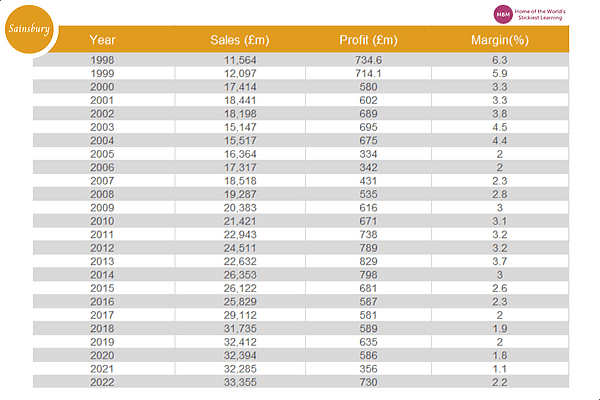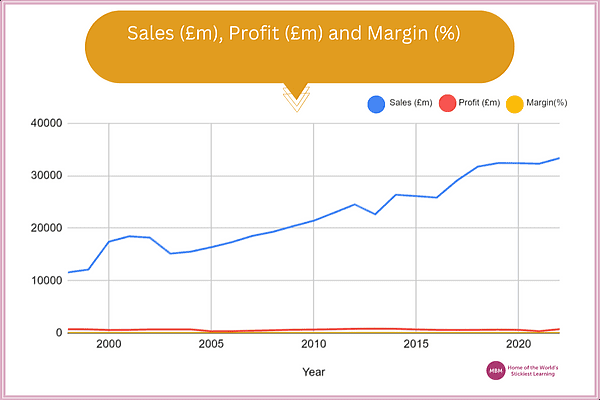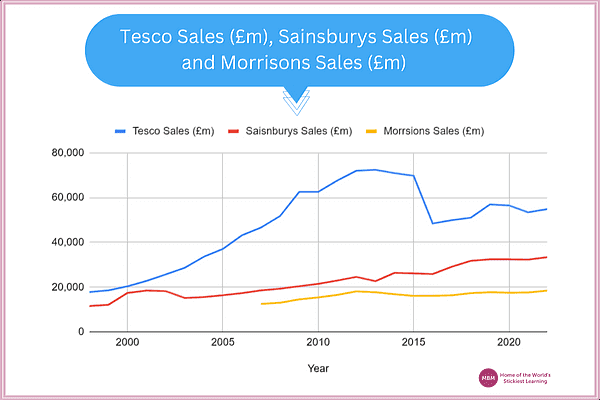A 25-year Sales Showdown of Uk’s Top Supermarkets
For the past 25 years, Tesco, Sainsbury’s, and Morrisons have been leading the pack as the largest and most popular of the Uk supermarkets.
Did you know that one of these supermarkets generated sales of £56.9 million in 2019, the highest among the three?
But how have these giants stacked up financially over the past two and a half decades?
In this article, we’ll take a deep dive into the sales and profits of Tesco, Sainsbury’s, and Morrisons. Particularly, we will analyse their performance and trends over the years. Let’s explore the fascinating insights we can glean from the past 25 years of data.

Tesco
TESCO was named after its founder, Jack Cohen. The company started as a market stall in London’s East End in 1919. Cohen began selling surplus groceries from the Army and set up the first TESCO store in 1929 in Burnt Oak, North London, using the TES of T.E. Stockwell, who was a supplier of tea, and CO from Cohen’s name.
Today, Tesco operates over 6,000 stores worldwide, serving millions of customers every week. The company is known for its diverse range of products, competitive prices, and innovative solutions. Their innovative solutions include Tesco Clubcard, which rewards loyal customers with discounts and other benefits.
Despite facing challenges such as increased competition and changing consumer habits, Tesco has remained a leading force in the UK retail industry. They lead with a strong focus on sustainability, community engagement, and customer satisfaction.
The following table shows the sales and profits of Tesco over 25 years, from 1998 to 2022. The data is presented in millions of pounds sterling (£m). The profit figures represent the amount of money the company made after deducting all expenses. The margin (%) indicates the percentage of profit relative to sales.


Insights
Based on the table, we can draw several insights regarding the sales, profit, and margin of the company over the years:
- The best year for the company was 2009, with sales of £62,537 million and a profit of £3,412 million. The worst year for the company was 2013, with sales of £72,400 million but a profit of only £2,000 million. This was due in part to accounting irregularities, which caused Tesco to overstate its profits by £263 million. The scandal resulted in the resignation of several senior executives and a major investigation by the UK’s Financial Conduct Authority.
- On the other hand, the worst year for the company in terms of profit was 2015, when it earned only £1,390 million. However, the lowest sales were recorded in 2016 when the company generated sales of only £48,400 million.
- The best decade for the company was the period from 2010 to 2020 when it consistently generated high sales and profit. However, this was an exception in 2013 and 2015. The company’s profit increased steadily during this period, from £3,412 million in 2009 to £2,502 million in 2019. This was due in part to a major cost-cutting program that Tesco had implemented in order to boost its margins.
- In 2020 and 2021, Tesco’s profits dipped again, falling to £2.1 billion and £1.8 billion respectively. This was likely due to the impact of the COVID-19 pandemic, which forced the company to close some stores and led to increased costs related to employee safety measures and supply chain disruptions.
- The average margin of the company over the years was around 4.5%, with the highest margin of 5.5% recorded in 2005, 2007, and 2009. The lowest margin of 2.0% was recorded in 2015 and 2016.

Some Key Dates of Announcements for Tesco Include:
- In 1997, Tesco introduced its loyalty card program, Clubcard, which quickly became one of the most successful retail loyalty schemes in the UK.
- In 2001, Tesco launched its online grocery shopping service, Tesco.com, which became the world’s largest online supermarket by 2006.
- In 2014, Tesco announced that it had overstated its profits by £263 million, leading to a significant drop in its share price and an investigation by the Financial Conduct Authority.
- In 2017, Tesco acquired the UK’s largest food wholesaler, Booker, for £3.7 billion, expanding its reach in the wholesale market and strengthening its position in the food industry.
- In 2020, Tesco announced that it would be cutting 4,500 jobs across its stores and offices in an effort to simplify its business and reduce costs.
- In 2021, Tesco announced that it would be closing its non-food website, Tesco Direct, and focusing on its core grocery business, as well as expanding its online offerings to include more third-party brands.
It’s also worth noting that Tesco typically announces its Q4 results in late February or early March each year.
Sticky Learning ® is 7 times more effective than 1-day training courses. Plus, you will get a Chain of Evidence proving your Return on Investment. Discover soft skills training that changes behaviours long term.

Sainsbury
Sainsbury’s is one of the largest supermarket chains in the UK, with a history dating back to 1869. The company has experienced a range of ups and downs over the past few decades, including major expansions and mergers, as well as challenges related to increased competition and economic downturns.
In terms of sales and profits, Sainsbury’s has seen steady growth over the past 25 years, with a few notable dips and spikes along the way. Some key milestones include the company’s acquisition of Homebase in 2000, its failed merger with Asda in 2019, and its ongoing efforts to adapt to changing consumer preferences and shopping habits.
As we delve deeper into Sainsbury’s financial performance over the past 25 years, we’ll explore some of the key trends and insights that have shaped the company’s success and challenges over time.


Insights
Based on the table, we can draw several insights regarding the sales, profit, and margin of the company over the years:
- The best year for Sainsbury’s in terms of sales was 2022, with £33,355 million in sales. This was also a good year for the company’s profit, with £730 million earned.
- The worst year for Sainsbury’s in terms of profit was 2015 when the company earned only £681 million in profit. The lowest sales were recorded in 2016, with £25,829 million generated.
- The company made efforts to turn things around with a new CEO appointed in 2004 and a renewed focus on customer service and product quality. These efforts paid off, with profits climbing back up to over £600 million by 2009.
- In 2014, Sainsbury’s announced a major acquisition of the Home retail group, which includes brands such as Argos and Habitat. This move was intended to diversify Sainsbury’s revenue streams and provide a stronger online presence.
- Despite the acquisition, Sainsbury’s saw a dip in profits in 2015 and 2016, with a profit margin of just 2.3% in 2016. This was partly due to intense competition in the UK supermarket industry, as well as the impact of Brexit on consumer confidence.
- The best decade for Sainsbury’s was the period from 2010 to 2020, during which the company consistently generated high sales and profit, with the exception of 2015 and 2016. The company’s profit increased steadily during this period, from £671 million in 2010 to £2,502 million in 2019.
- The average margin for Sainsbury’s over the years was around 2.9%, with the highest margin of 6.3% recorded in 1998 and the lowest margin of 1.1% in 2021.
- The best year for Sainsbury’s was 2009, with £20,383 million in sales and a profit of £616 million. The worst year for the company was 2005, with sales of £16,364 million and a profit of only £334 million.
- It is noteworthy that the best year for Sainsbury’s, 2009, was only around three times better than the worst year, 2005, in terms of profit. This indicates that the company has faced challenges in achieving consistent profitability over the years.
In recent years, Sainsbury’s has continued to face challenges in the highly competitive UK supermarket industry, with profit margins remaining relatively low. However, the company has also continued to invest in digital capabilities and online sales channels, with online sales accounting for an increasing proportion of total sales.
Some Key Announcement Dates for Sainsbury’s Include
- November 14, 2018: Sainsbury’s announces its proposed merger with Asda.
- April 25, 2019: UK regulators blocked the proposed Sainsbury’s-Asda merger.
- September 30, 2021: Sainsbury’s announces its half-year financial results for the period ending September 25, 2021, reporting a profit of £250 million and a profit margin of 1.2%.
Failed Sainsbury’s and Asda Merger

One of the most significant key dates in the history of the UK supermarket industry was the proposed merger between Sainsbury’s and Asda in 2019. The two retailers announced the planned merger in April 2018, stating that it would create the largest supermarket chain in the UK, with a combined market share of around 31%. The merger would have also allowed the two companies to leverage their strengths to reduce costs, improve the quality of products and services, and increase their online offerings.
However, the proposed merger was not without controversy. Concerns were raised over potential job losses and store closures. Hence the Competition and Markets Authority (CMA) launched an investigation into the merger in September 2018. After conducting a detailed review of the proposed merger, the CMA blocked the merger in April 2019. They stated that the merger would lead to higher prices and fewer choices for consumers.
The failed merger was a significant event for the UK supermarket industry. This is so because it showed the challenges that retailers face when trying to consolidate their position in the market. It also highlighted the increasing scrutiny that regulators are placing on large mergers and acquisitions in the sector. This is because they seek to ensure that competition is not stifled and that consumers continue to benefit from low prices and choices.
Morrisons
Morrisons is a British supermarket chain that was founded in 1899 by William Morrison. They are known for its focus on fresh, locally sourced produce and its commitment to offering its customers high-quality, affordable products.
Like many other retailers, they have faced a number of challenges over the past few years, including increased competition from discount retailers and online shopping platforms. However, the company has also implemented a number of successful initiatives to help it stay competitive, such as expanding its online delivery services and launching new product lines. In recent years, Morrisons has also made efforts to reduce its environmental impact and promote sustainable practices throughout its supply chain.
Overall, their sales and profits have seen some fluctuations over the past 25 years, with a few major peaks and dips. However, the company has remained a major player in the UK supermarket industry, and its commitment to quality and affordability has helped it maintain a loyal customer base.


Insights
From the table, we can glean insights into Morrisons’ sales, profit, and margin over the years:
- Morrisons’ top year for sales and profit was 2022, with £18.4bn in sales and £828m in profit.
- 2015 was the company’s worst year for profit, earning only £242m, and sales were also low at £16.1bn.
- The decade from 2010 to 2020 was the company’s best, with high sales and profits, except for 2013 and 2014. Profits rose steadily from £767m in 2010 to £406m in 2019.
- The average margin of Morrisons over the years was around 3.2%. The highest margin of 5.3% was recorded in 2011 and the lowest margin of 1.1% was recorded in 2021.
- The profit margin increased significantly from 2.1% to 2.9% between 2014 and 2017 due to cost management, pricing, and product mix. However, it decreased after 2017.
Some Key Dates of Announcements for Morrisons Include:
- In 2014, they announced a major restructuring plan. This included cutting 2,600 jobs and closing 23 underperforming stores.
- In 2016, they announced that they had signed a deal with Amazon to provide the online retailer with fresh and frozen food products.
- In 2020, they announced that they would be launching a range of food boxes. This was to help customers during the COVID-19 pandemic.
- In 2021, they announced that they had agreed to be acquired by a private equity group led by Fortress Investment Group for £6.3 billion.
It’s also worth noting that Morrisons typically announces its full-year results in March or April each year.
Comparing the Numbers

- Tesco has consistently had the highest sales figures, with £54.8 billion in 2022. Compare this to Sainsbury’s £33.4 billion and Morrisons’ £18.4 billion.
- Sainsbury’s and Morrisons have similar sales trends over time, with Sainsbury’s generally having slightly higher sales than Morrisons.
- All three retailers experienced a dip in sales in 2016. This may have been due to increased competition from discount retailers such as Aldi and Lidl.
- Despite the dip in 2016, all three retailers have generally experienced steady growth in sales over the past decade.
- The COVID-19 pandemic appears to have had a minimal impact on sales for all three retailers. Sales figures for 2020 and 2021 are relatively consistent with previous years.

Impact of Discounters: The Rise of Aldi and Lidl
The UK supermarket industry has undergone significant changes in the last few decades. The rise of discounters such as Aldi and Lidl is one of the most notable trends. These German-based retailers first entered the UK market in the 1990s. Since then, they have expanded rapidly, challenging the dominance of established supermarket chains. With their focus on low prices, no-frills stores, and private label products, discounters have been able to attract a growing number of price-conscious consumers who are looking to save money on their grocery shopping.
Impact on Traditional Supermarkets
The success of Aldi and Lidl has put pressure on traditional supermarkets. Supermarkets are forced to adapt to changing consumer preferences and stay competitive. Many established retailers have responded by launching their discount brands or revamping their existing private label ranges. They have also invested heavily in online shopping and home delivery services to meet the growing demand for convenience. However, some analysts argue that the traditional supermarket model may be outdated. Moreover, discounters have exposed flaws in the industry’s business model. Specifically, these are flaws such as over-reliance on promotions and a lack of innovation.
Consumer Behaviour
The rise of discounters has also had a significant impact on consumer behaviour. Price is no longer the only factor influencing where people shop, but it has become increasingly important. Many consumers now visit multiple retailers to find the best deals. These days they are more likely to switch between brands based on price and value. This has led to a more fragmented market, with consumers buying from a range of different retailers. And these retailers include discounters, traditional supermarkets, and online retailers.
Overall, the impact of discounters on the UK supermarket industry has been significant and shows no sign of slowing down. As consumer behaviour and preferences continue to evolve, retailers will need to adapt and innovate to stay competitive.
The Growing Importance of Sustainability for UK Supermarkets

Initiatives to Reduce Waste and Carbon Emissions
UK supermarkets are increasingly focusing on sustainability. One key area where they have made progress is in reducing waste and carbon emissions. Many supermarkets have implemented initiatives such as reducing packaging, increasing the use of recyclable materials, and improving supply chain efficiency to minimise waste.
They have also invested in renewable energy sources and technologies to reduce carbon emissions. For example, Tesco has committed to using 100% renewable electricity by 2030. They are working to reduce food waste by redistributing unsold food to charities.
Consumer Demand for Sustainable Products
Consumers are increasingly demanding sustainable products, and UK supermarkets have responded by expanding their range of eco-friendly and ethical products. Many supermarkets have introduced their own-label sustainable products. These include organic and Fairtrade products. They have also started working with suppliers to ensure sustainable sourcing of raw materials. This has been driven by a growing awareness among consumers of the environmental impact of their purchases and a desire to make more ethical choices.
Future Outlook for Sustainability in the Industry
The future outlook for sustainability in the UK supermarket industry is positive, with many companies making ambitious sustainability commitments. For example, Morrisons has pledged to be net-zero carbon by 2040. Also, Sainsbury’s has committed to achieving net-zero carbon emissions by 2040, as well as halving food waste by 2030.
The industry is also likely to continue to invest in new technologies to reduce waste and carbon emissions. These include by use of electric vehicles for deliveries and the development of more sustainable packaging materials. Both consumer demand and the need to address environmental challenges drive the continued trend towards sustainability in the industry.
Conclusion
In conclusion, the UK’s top three supermarkets had their share of successes and challenges over the past few decades. They’ve faced increased competition from discount retailers and online shopping. Despite this, these supermarkets have managed to adapt and remain dominant players in the industry.
The UK supermarket industry is a dynamic and ever-evolving landscape, with new challenges and opportunities emerging all the time. These three supermarkets and other players in the industry will continue to adapt and innovate in the years to come. And it will be quite interesting to see.
Action: For more about grocery, check out our ultimate guide on GSCOP.




